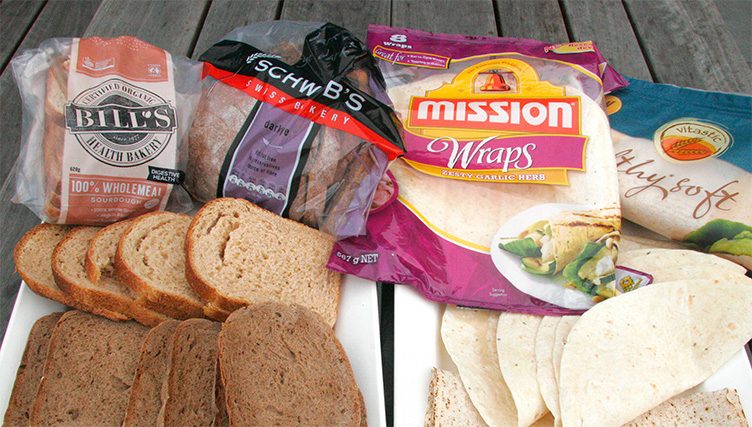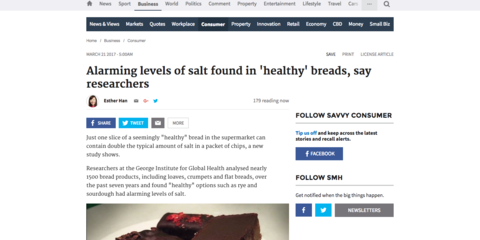
‘Healthy’ breads contain more salt than a packet of chips, study finds
It’s a staple eaten by millions of Australians, but a new study has revealed the hidden levels of salt within our daily bread.
Researchers from The George Institute for Global Health analysed 1439 bread products from 2010-2017 and found some loaves contained more than a of third of the daily recommended salt intake in just two slices. Loaves, rolls, morning staples such as crumpets, bagels and English muffins, as well as flat breads were all studied.
Rye breads were revealed to contain on average 20 per cent more salt than targets set by the Australian Food and Health Dialogue (FHD). Flat bread such as wraps, naan, roti and tortillas also included unnecessary high levels of salt, on average containing a third more salt than white bread.
The results were released to mark the 10th World Salt Awareness Week (20 – 26 March 2017) and examined how salt levels have changed since 2010.
Lead author Clare Farrand said the study showed salt levels in breads and bread rolls had dropped by some 10 per cent in seven years. But added that too many commonly eaten products still contain excessive amounts of salt. “There has been a clear and welcome drop in salt levels in bread, particularly in those products that were covered by the salt reduction targets. However, some breads, still contain high levels of salt.
“We know that excess salt in our diet increases blood pressure and the risk of stroke and cardiovascular disease, so our findings are incredibly worrying especially as many of the products that have the highest levels of salt are perceived by families as being the healthiest.”
The loaves with the highest salt levels were Schwob’s Dark Rye, with just one slice containing more than double the amount of salt as a serving of Kettles sea salt crisps.1 Artisan baker Bowan Island’s Wholemeal Sourdough also stood out for its high salt content (1.6g salt/100g), almost THREE TIMES saltier than the lowest option Bill’s Certified Organic 100% Wholemeal Sourdough (0.6g salt/100g).
Ms Farrand, public health nutritionist with The George Institute, added: “Whilst it is important to look at the salt content, it’s also worth noting these breads are a good source of fibre so do have something to offer in terms of dietary needs. Our advice is to look for high fibre breads that are also low in salt.
“They are on the supermarket shelves, you just need to check the label carefully. An app like FoodSwitch2 can help guide you to making the healthiest choice of all.”
The report highlighted high levels of salt in flat breads, with Mission Chapattis Garlic topping the list with 2.3 grams of salt per 100g grams per serve – 23 times more salt than the flat bread with the least amount of salt - Missions’ White Corn Tortillas.
Flat breads were not covered by the FHD salt reduction targets and only 34% of these products would meet the salt target (400mg/100g). Crumpets also received a fail in the report, with not a single crumpet meeting FHD salt targets.
Ms Farrand, of The George Institute, concluded: “The variation in salt levels amongst bread products is huge, which clearly demonstrates manufacturers can produce much lower salt products.
“What Australia needs though is a consistent drop in salt levels across all processed foods, not just in in some breads. This can only be achieved if we have comprehensive government and industry supported salt reduction targets for all product categories.
“Limiting the amount of salt in our most consumed foods would not only save lives, it would also reduce the burden on the Australian health system”.
Salty facts
- The average Australian adult eats around 8-10 grams of salt each day, almost double the World Health Organisation recommendation of less than 5 grams per day.
- Processed and packaged foods account for around 75 per cent of salt in the Australian diet.
- Globally it has been estimated that more than 1.65 million cardiovascular deaths per year and attributed to excess dietary salt intake.
- In 2009 the FHD set voluntary salt reduction targets to be achieved in three major food categories (ready to eat breakfast cereals, breads and processed meats) to try and achieve the World Health Organisation’s aim of reducing global salt intake by 30 per cent by 2025. The target for bread products was set as 400mg/100g.
- The current government’s Healthy Food Partnership is currently prioritising nutrients and foods and will set goals for reformulation and clear measures to track progress.
Download the top findings of our salt in bread study. (PDF 64KB)
Download the full report of findings of our salt in bread study). (PDF 490KB)
1. The average serving of Kettle original sea salt crisps contain 0.55g salt per 45g serving.
2. A smartphone app that allows consumers to get immediate, easy-to-understand information about packaged food products as well as a list of similar foods that are healthier choices.











